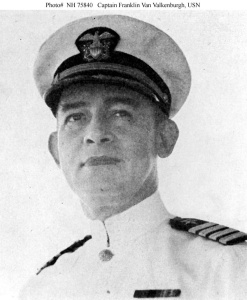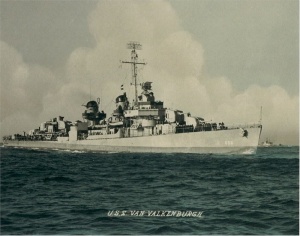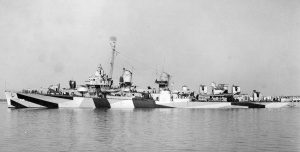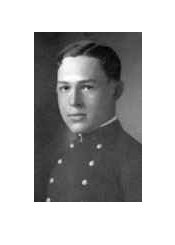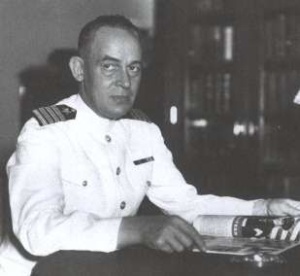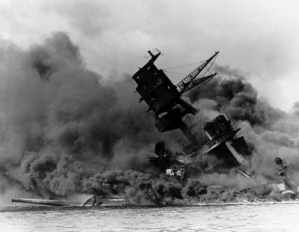

 Franklin Van Valkenburgh
Franklin Van Valkenburgh 

General Notes
This Navy captain was posthumously awarded the Congressional Medal of Honor. "Captain Van Valkenburgh, commanding officer of the USS Arizona, was killed when that ship was blown up during attack on Pearl Harbor. He was born in Minneapolis, Minn April 5, 1888, and was appointed to Annapolis from Wisconsin in 1905. He studied postgraduate engineering at Annapolis and Columbia University from 1915 to 1917. During World War I he served aboard the USS Rhode Island, for which he was awarded the Victory Medal, Atlantic Fleet Clasp. Captain Van Valkenburgh's home was at 3023 East Ocean Boulevard, Long Beach. Calif." Married: 1 JUL 1914 in Olongapo, Zambales, Phillipines Jane Carleen VAN VALKENBURGH b: 6 APR 1915 in Milwaukee, Wisconsin Elizabeth Ann VAN VALKENBURGH b: 22 APR 1917 in Hackensack, New Jersey Franklin Butler VAN VALKENBURGH b: 5 May 1919 in Annapolis, MD Franklin Van Valkenburgh-born on 5 April 1888 at Minneapolis, Minn., and appointed a midshipman on 15 September 1905-graduated from the Naval Academy on 4 June 1909. After service in Vermont (Battleship No. 20) and in South Carolina (Battleship No. 26), Van Valkenburgh was commissioned ensign on 5 June 1911. Traveling to the Asiatic Station soon thereafter, he joined Rainbow (Submarine Tender No. 7) at Olongapo, Philippine Islands, on 11 September. He reported to Pampanga (Gunboat No. 39) as executive officer on 23 June 1914 for a short tour in the southern Philippines before his detachment on 4 August. After returning to the United States, Lt. (jg.) Van Valkenburgh joined Connecticut (Battleship No. 18) on 11 November. Following postgraduate work in steam engineering at the Naval Academy in September 1915, he took further instruction in that field at Columbia University before reporting to Rhode Island (Battleship No. 17) on 2 March 1917. The entry of the United States into World War I found Van Valkenburgh serving as the battleship's engineering officer. Subsequent temporary duty in the receiving ship at New York preceded his first tour as an instructor at the Naval Academy. On 1 June 1920, Van Valkenburgh reported on board Minnesota (Battleship No. 22) for duty as engineer officer, and he held that post until the battleship was decommissioned in November 1921. He again served as an instructor at the Naval Academy-until 15 May 1925-before he joined Maryland (BB-46) on 26 June. Commissioned commander on 2 June 1927 while in Maryland, he soon reported for duty in the Office of the Chief of Naval Operations on 21 May 1928 and served there during the administrations of Admirals Charles F. Hughes and William V. Pratt. Detached on 28 June 1931, Van Valkenburgh received command of Talbot (DD-114) on 10 July and commanded Destroyer Squadron 5 from 31 March 1932. After attending the Naval War College, Newport, R.I., and completing the senior course in May 1934, Comdr. Van Valkenburgh next served as inspector of naval materiel at the New York Navy Yard before going to sea again as commanding officer of Melville (AD-2) from 8 June 1936 to 11 June 1938. Promoted to captain while commanding Melville-on 23 December 1937-he served as inspector of materiel for the 3d Naval District from 6 August 1938 to 22 January 1941. On 5 February 1941, Van Valkenburgh relieved Capt. Harold C. Train as commanding officer of Arizona (BB-39). Newly refitted at Puget Sound, Arizona served as flagship of Battleship Division 1 for the remainder of the year, based primarily at Pearl Harbor with two trips to the west coast. On 4 December, the battleship went to sea in company with Nevada (BB-36) and Oklahoma (BB-37) for night surface practice and, after conducting these gunnery exercises, returned to Pearl Harbor independently on the 6th to moor at berth F-7 alongside Ford Island. Both Capt. Van Valkenburgh and the embarked division commander, Rear Admiral Isaac C. Kidd, spent the next Saturday evening, 6 December, on board. Suddenly, shortly before 0800 on 7 December, Japanese planes roared overhead, shattering the Sunday peace and punctuating it with the explosion of bombs and the staccato hammering of machine guns. Capt. Van Valkenburgh sped forward from his cabin and arrived on the navigation bridge where he immediately began to direct his ship's defense. A quartermaster in the pilot house asked if the captain wanted to go to the conning tower-a less-exposed position in view of the Japanese strafing-but Van Valkenburgh refused to do so and continued to man a telephone, fighting his ship. A violent explosion suddenly shook the ship, throwing the three occupants of the bridge-Van Valkenburgh, an ensign, and the quartermaster, to the deck, and shattering the bridge windows. Dazed and shaken, the ensign stumbled through the flames and smoke and escaped, but the others were never seen again. A continuing fire, fed by ammunition and oil, blazed for two days until finally put out on 9 December. A subsequent search recovered only Capt. Van Valkenburgh's class ring. The captain was posthumously awarded the Medal of Honor-the citation reading in part: "for devotion to duty . . . extraordinary courage, and the complete disregard of his own life." In gallantly fighting his ship, he directed its defense in the tragically short time allotted him.
-
Ancestor Pedigree Chart
-
*There are earlier generations for the ancestor(s) indicated. See their page(s) for details (click name)



 - b.12 Jun 1720 in Kinderhook, Columbia County, New York d.22 May 1802
- b.12 Jun 1720 in Kinderhook, Columbia County, New York d.22 May 1802



 - b.25 May 1753 in Claverack, Columbia County, New York d.04 Aug 1831 in Auburn, Cayuga County, New York
- b.25 May 1753 in Claverack, Columbia County, New York d.04 Aug 1831 in Auburn, Cayuga County, New York




 - b.<13 Oct 1728
- b.<13 Oct 1728


 - b.28 May 1795 in Kinderhook, Columbia County, New York d.03 Mar 1879 in Jacksonville, Florida
- b.28 May 1795 in Kinderhook, Columbia County, New York d.03 Mar 1879 in Jacksonville, Florida




 - b.09 Oct 1727 in Albany, New York
- b.09 Oct 1727 in Albany, New York



 - b.21 May 1765 in Auburn, Cayuga County, New York d.14 May 1854 in Prattsburg, Steuben County, New York
- b.21 May 1765 in Auburn, Cayuga County, New York d.14 May 1854 in Prattsburg, Steuben County, New York




 - b.15 Jul 1748 in Kinderhook, Columbia County, New York
- b.15 Jul 1748 in Kinderhook, Columbia County, New York

 - b.21 Feb 1835 in Prattsburg, Steuben County, New York d.09 May 1924 in Prattsburg, Steuben County, New York
- b.21 Feb 1835 in Prattsburg, Steuben County, New York d.09 May 1924 in Prattsburg, Steuben County, New York



 - b.1761 d.1842
- b.1761 d.1842


 - b.Oct 1793 in Lyme, Connecticut d.10 May 1871 in Racine, Wisconsin
- b.Oct 1793 in Lyme, Connecticut d.10 May 1871 in Racine, Wisconsin



 - b.12 May 1762 in New Haven, Connecticut
- b.12 May 1762 in New Haven, Connecticut
 - b.08 Jun 1863 in Milwaukee, Wisconsin d.13 Aug 1900 in Milwaukee, Wisconsin
- b.08 Jun 1863 in Milwaukee, Wisconsin d.13 Aug 1900 in Milwaukee, Wisconsin




 - b.13 Jul 1841 in Albans, Maine d.24 May 1933
- b.13 Jul 1841 in Albans, Maine d.24 May 1933




- b.05 Apr 1888 in Minneapolis, Minnesota d.07 Dec 1941 in Pearl Harbor, Hawaii
 - b.25 Dec 1865 in Clearfield, Curwensville County, Pennsylvania
- b.25 Dec 1865 in Clearfield, Curwensville County, Pennsylvania
-
-
Individual Additional Information
-
Associated external link http://en.wikipedia.org/wiki/Franklin_Van_Valkenburgh
 Details of Franklin's family with Marguerite Horne
Details of Franklin's family with Marguerite Horne
Source/Citation
The Van Valkenburg Family in America, Paul I Van Valkenburg
The Van Valkenburg Family in America, Paul I Van Valkenburg
